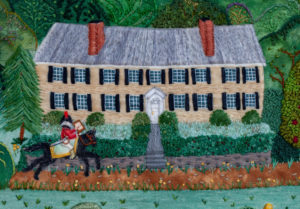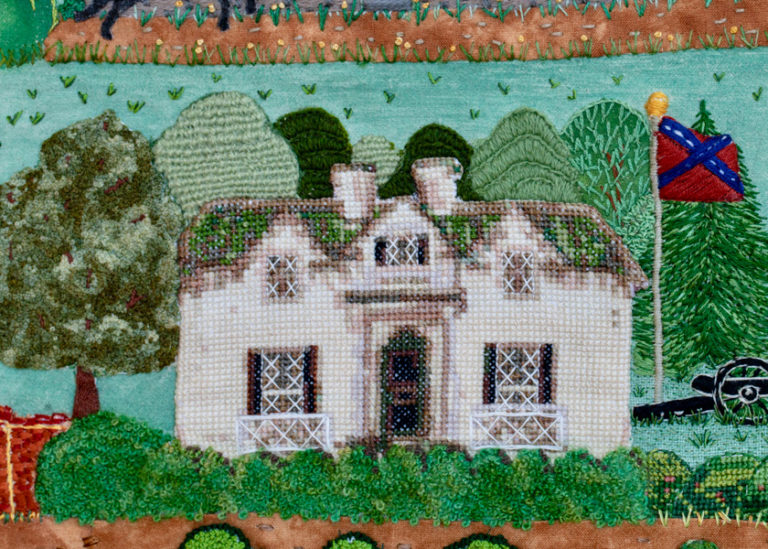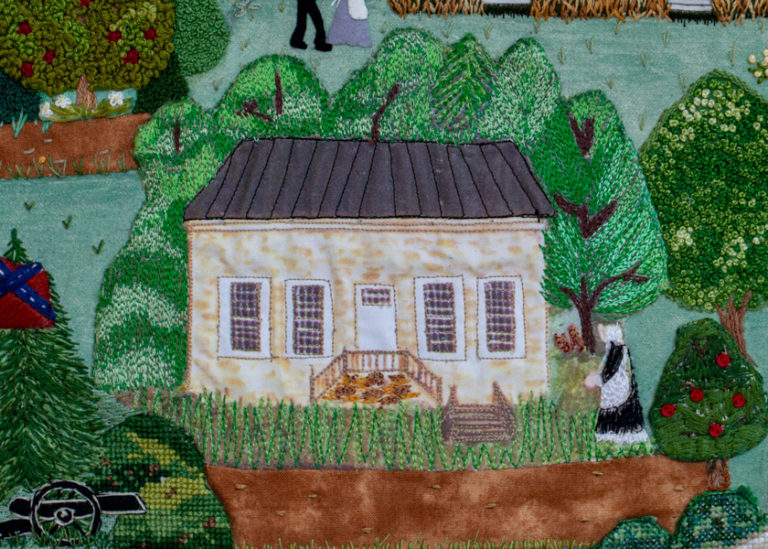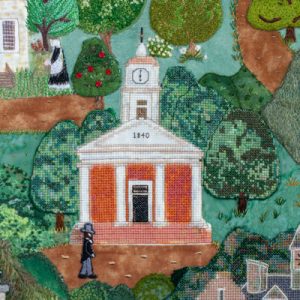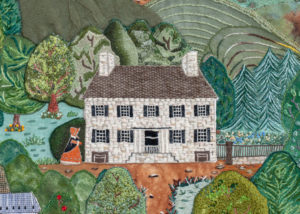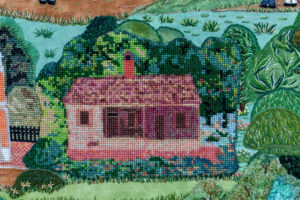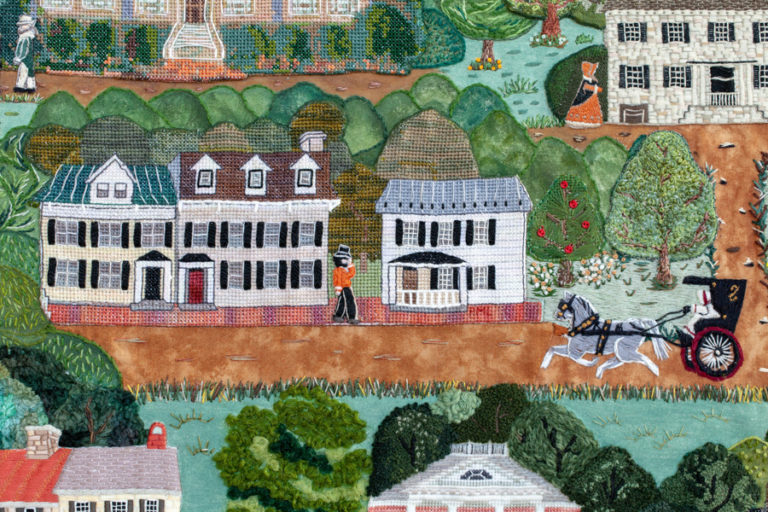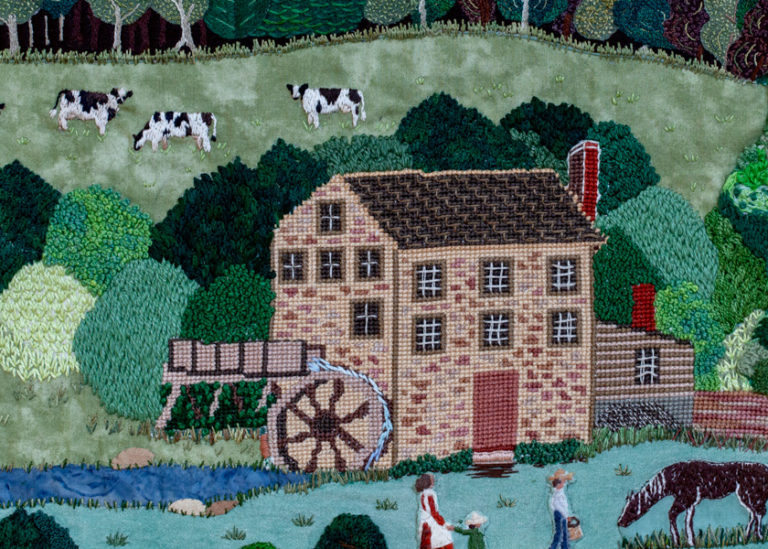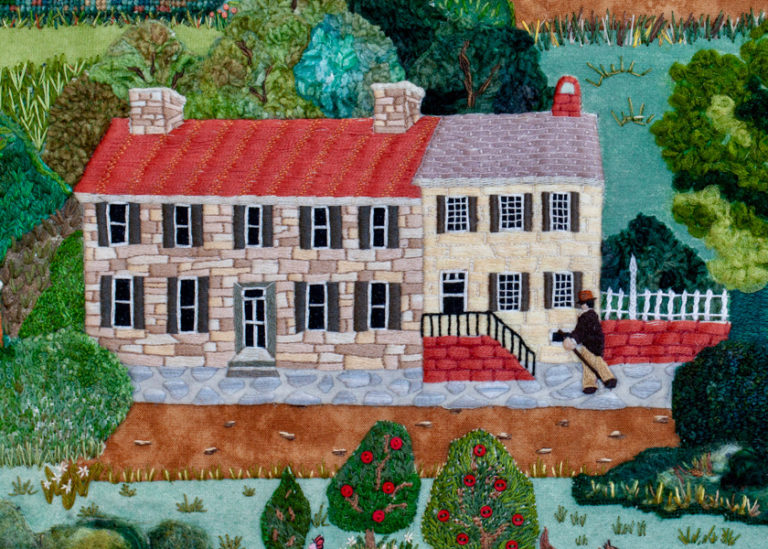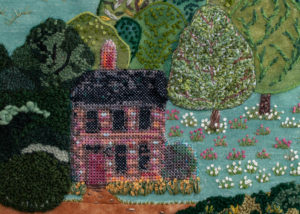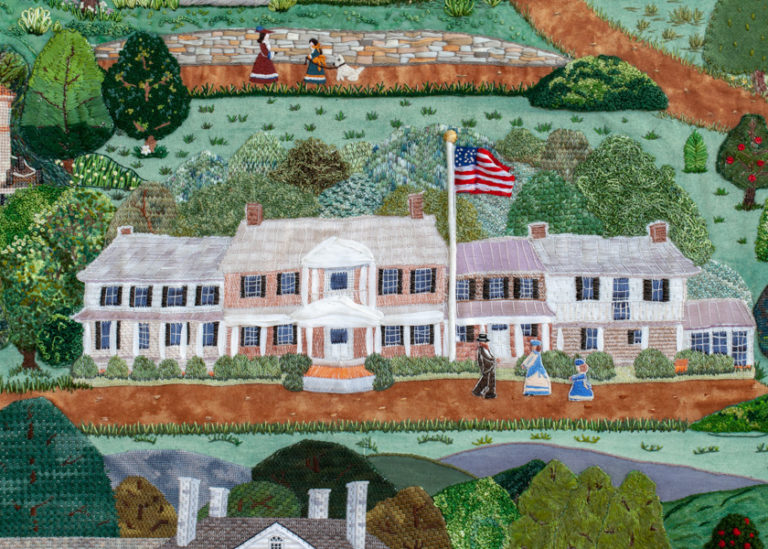Historic Buildings
1. WILLOW SHADE
Adapted and Stitched by Elaine W. Evans
Needlepoint on Linen Canvas, Painted Canvas, DMC Cotton Floss
WILLOW SHADE was the childhood home of Willa Cather. The successful, Pulitzer Prize-winning author, who lived there from 1874 – 1883, is best known for her Prairie Trilogy, but her last novel was set in the Valley – and at this house.
ADOPTED BY DONNA PENCE
2. AMBLER HILL
Adapted and Stitched by Lucy Edmison
Surface Embroidery on Kona Cotton, DMC Cotton Floss, Appleton Wool
AMBLER HILL, built about 1786, was a large property with gardens and orchards, takes its name from John Ambler, who married the widow of the first owner. It is perhaps most famous as the birthplace of John Esten Cooke, popular novelist of the late 19th century.
ADOPTED BY MAGGIE AND MIKE FRASER
3. HOPEWELL FRIENDS’ MEETING HOUSE
Adapted and Stitched by Maggie Fraser
Surface Embroidery on Kona Cotton, DMC, Cottage Garden, Blanc Neige
Threads
HOPEWELL FRIENDS’ MEETING HOUSE. Pennsylvania Quakers arrived in the Valley in the 1730s and established this congregation. This building dates from 1870, the previous one having been destroyed in the Civil War. It is in regular use.
ADOPTED BY THE OATLANDS CHAPTER, EGA
4. BALTIMORE & OHIO STATION
The building was stitched by Jackie Partlow. The people were stitched by Lucy Edmison. The railroad track was stitched by Alice Reaves.
Cross Stitch, Surface Embroidery, Appliqué, DMC Cotton Floss, Hand Dyed Threads
THE BALTIMORE & OHIO STATION, built in 1892-93 is emblematic of the town’s long commercial ties to Baltimore and the north.
ADOPTED BY IRINA NOVASH
5. GLEN BURNIE HOUSE
Stitched by Barbara Jackson
Cross Stitch, DMC Cotton Floss
GLEN BURNIE was built by Robert Wood in 1794 on the site of his father Col. James Wood’s 1737 log house. The Colonel founded Winchester in 1752, and conducted city and court business from his house. The 1794 house and later gardens are now a museum.
ADOPTED BY THE WILLIAMSBURG ROSE AND THISTLE CHAPTER, EGA
6. STONEWALL JACKSON’S HEADQUARTERS
The building was stitched by Cissy Shull. The trees and bushes were stitched by Lucy Edmison, Sarah McCarty, Anne Saarinen, Nina Vassallo.
Cross Stitch, Surface Embroidery, DMC Cotton Floss, Appleton Wool
STONEWALL JACKSON’S HEADQUARTERS. Lt. Col. Lewis T. Moore built this house in 1854, and lent it to Gen. Thomas J. Jackson for use as his offices when the Confederate army wintered around Winchester in the winter of 1861 – 1862. It is now a museum.
ADOPTED BY THE WILLIAMSBURG ROSE AND THISTLE CHAPTER, EGA
7. OLD STONE PRESBYTERIAN CHURCH
Adapted and Stitched by Lind Miles
Appliqué, Free Motion Machine Embroidery, Cotton Quilting Threads
THE OLD STONE PRESBYTERIAN CHURCH, from 1780, is the oldest church building in town. It has seen a variety of uses, most notably as the city’s first school for colored children, from 1878 – 1927. It has been restored as a church.
ADOPTED BY ALISON HERRING, IN MEMORY OF BARBARA ALEXANDER HERRING OF ARKANSAS
8. FREDERICK COUNTY COURT HOUSE
The building was stitched by Stephany Wisecarver. The judge was stitched by Alice Reaves.
Cross Stitch, Surface Embroidery, DMC Cotton Floss
FREDERICK COUNTY COURT HOUSE was built in 1840 to replace the first 1744 log building, and was in use for 144 years. In the turmoil of the Civil War, it was taken over in turn by each side to confine prisoners after local battles. It is now a Civil War museum.
ADOPTED BY MARGARETTA BARTON COLT, EDITH SHEERIN PATERSON, ANNE SHEERIN AND CHARLES SHEERIN, IN MEMORY OF EDITH BARTON SHEERIN
9. MT. HEBRON GATE HOUSE & CEMETERY
OLD LUTHERAN CHURCH RUINS MONUMENT TO THE CONFEDERATE UNKNOWN
Adapted and Stitched by Mary Andrews
Surface Embroidery, DMC Cotton Floss, Wisper Threads
HEBRON CEMETERY, virtually in the shadow of the ruins of the old Lutheran Church, was established in 1844 as a non-denominational cemetery for the town. The adjacent Confederate Cemetery, with its monument to the unknown, was founded just after the war to provide for the remains of soldiers found in the nearby battlefields.
ADOPTED BY SUZANNE DAVIS
10. HEXAGON HOUSE
Adapted and Stitched by Karen B. Ryan
Surface Embroidery, DMC Cotton Floss, Hand Dyed Silk and Hand Dyed Roving
THE HEXAGON HOUSE, an embodiment of a mid-19th century fad for polygonal buildings, was built in 1874 by James W. Burgess, who never lived there due to financial reverses. It now houses the offices of Preservation of Historic Winchester.
ADOPTED BY THE PIEDMONT CHAPTER, ANG
11. SHERIDAN’S HEADQUARTERS
Adapted and Stitched by Patti Lynn Tidemann
Surface Embroidery on Linen, DMC Cotton, Alpaca and Angora Wool Threads, Kreinik
SHERIDAN’S HEADQUARTERS, the Logan House. Lloyd Logan, a successful tobacco merchant, built the house in 1854. It was the grandest house in town and so was requisitioned by successive Federal commanders, the first of whom, Gen. Robert Milroy, sent the Logan family south into exile.
ADOPTED BY THE COLONIAL WEST CHAPTER, EGA
12. HANDLEY LIBRARY
The building was adapted and stitched by Kathy Crosby, Becky Ebert, Jennifer Sutter. The trees were stitched by Margret Bomar.
Surface Embroidery on Linen, DMC Cotton, Wool, Linen Threads
THE HANDLEY LIBRARY, a magnificent Beaux-Arts building, opened in 1913. It was financed by a bequest of Judge John Handley of Scranton, Pa., and was designed to suggest the shape of a book.
ADOPTED BY MARGARETTA BARTON COLT
13. ROUSS CITY HALL
Stitched by Nina Vassallo
Cross Stitch, Surface Embroidery, DMC Cotton Floss
ROUSS CITY HALL was built from 1900 to 1902. It was named for Winchester’s other great benefactor, Charles B. Rouss, whose generosity endowed several municipal projects. It was a multi-purpose building serving a variety of civic functions.
ADOPTED BY CHARLENE AND ROBERT SHIPP
14. GODFREY MILLER HOUSE
Adapted and Stitched by Sally Anderson
Surface Embroidery, DMC Cotton Floss
THE GODFREY MILLER HOUSE, a handsome stone building dating from 1787, was in the Miller family from 1812 until 1938. Margaretta Miller, left the house to Grace Evangelical Lutheran Church. It is used as a fellowship center.
ADOPTED BY THE SHARP SISTERS
15. DANIEL MORGAN HOUSE
The building was adapted and stitched by Betsy Morgan. The trees were stitched by Sarah Weisse.
Surface Embroidery, Counted Thread on Linen, DMC Cotton Floss, Gloriana 12 ply Hand Dyed Silk Floss
THE GENERAL DANIEL MORGAN HOUSE, built in 1787, was used by the famous frontiersman, soldier and congressman only in the last years of his life. Morgan served in the French and Indian War, and then in the Revolution from 1775 – 1781.
ADOPTED BY GEORGE AND JEANNE SCHEMBER
16. CHRIST EPISCOPAL CHURCH
Stitched by Cindy Hawkins
Cross Stitch, DMC Cotton Floss
CHRIST EPISCOPAL CHURCH was founded in 1738 as the established Church of England. This, the third church, was built in 1826 – 1827 in the Gothic Revival style and signified the revival of that denomination. There have been numerous additions, such as the 1855 belfry.
ADOPTED BY THE FAMILY OF RANDOLPH BARTON III
17. GEORGE WASHINGTON’S OFFICE
Adapted and Stitched by Kristen Goff
Cross Stitch, DMC Cotton Floss
GEORGE WASHINGTON’S OFFICE, the core of this building (also known as the Kurtz House), was built about 1748 and used by Washington when he was Lord Fairfax’s surveyor, and also later he directed the construction of Fort Loudoun during the French and Indian War.
ADOPTED BY THE CHINCOTEAGUE CREWEL RETREAT
18&19. CHRISTIAN STREIT HOUSE & HENRY ST. GEORGE TUCKER LAW OFFICE & SCHOOL
Stitched by Pamela Lakin
Cross Stitch, DMC Cotton Floss
Built in 1757, the CHRISTIAN STREIT HOUSE is named for its long ownership by the Lutheran minister, Revolutionary War chaplain and educator. Several additions were made to accommodate his growing family of sixteen children, and also for his Latin school. THE HENRY ST. GEORGE TUCKER LAW OFFICE AND SCHOOL building was used from 1824 -1831 by the eminent lawyer, legislator and jurist to educate the next generation of Winchester lawyers. Evelina Streit later ran a female academy here.
ADOPTED BY KEVIN AND PAMELA LAKIN
20. SPRINGDALE MILL
The building was stitched by Brenda Douglass. The trees were stitched by Betty Lowdermilk.
Cross Stitch, Needlepoint on Linen; DMC Cotton Floss, Wool, Silk
The mill at Bartonsville on the Opequon Creek was one of several mills on the creek and many in the county. Built around 1788, it milled flour, and probably was in operation well into the twentieth century. Wheat was the most important crop in the Valley.
ADOPTED BY IRINA GALOUNINA AND PETER POLIAKOV
21. JOHN HANDLEY HIGH SCHOOL
Adapted and stitched by Elaine W. Evans. Surface Embroidery on Linen, DMC Cotton Floss
HANDLEY HIGH SCHOOL was the other significant gift of Judge John Handley. Founded in 1923, it has served generations of the town.
ADOPTED BY SOPHIA, ALEXANDER, ANGELIKA, AND JEFF SWIFT
22. RED LION TAVERN
Adapted and Stitched by Hildegard Strydom.
Surface Embroider, DMC Cotton Floss
THE RED LION TAVERN was opened around 1783 by Peter Lauck, one of Gen. Daniel Morgan’s riflemen, and probably was the site of many a gathering of those veterans. It was a tavern until 1842.
ADOPTED BY BRENDA DOUGLASS
23. THORN HILL MANOR
Adapted and Stitched by Jane Ashbaugh
Counted Thread, DMC Cotton Floss, Sampler Threads, Crochet Cotton, Tatting Threads
THORN HILL MANOR was built by Robert White Jr. in the Federal style, but has been modified many times. White, a prominent lawyer and judge, lived there until 1831.
ADOPTED BY THE LOUDOUN SAMPLER GUILD
24. SIMON LAUCK HOUSE
Stitched by Elizabeth Bolduc
Cross Stitch, DMC Cotton Floss
Simon Lauck, brother of Peter, is believed to have served with Gen. Daniel Morgan during the Revolution. He later became a gunsmith and this was his shop.
ADOPTED BY SARAH MCCARTY
25. FORT STEPHENS
The building was stitched by Teber Amos. The trees were stitched by Betty Lowdermilk.
Needlepoint on Canvas, DMC Cotton Floss, Wool, Silk, Silk Straw
FORT STEPHENS, near Cedar Creek, was built around 1752 by one of the early settlers, Lewis Stephens, to protect his family and neighbors in case of Indian attack. It was one of many such frontier forts. During the Revolution, it became a munitions factory.
ADOPTED BY BETTY LOWDERMILK
26. SPRINGDALE
Adapted and Stitched by Shelley Anderson
Needlepoint on Congress Cloth, Silk, Cotton, Wool Threads
SPRINGDALE, the oldest house in the county, was built in 1753 by Col. John Hite, a son of the original settler Jost Hite. It descended in that family until purchased by Richard P. Barton in 1802; several generations of the Barton family lived there until 1873.
ADOPTED BY THE SHENANDOAH CHAPTER, ANG, AND SUSAN CLAYTOR
27. ABRAM’S DELIGHT
Adapted and Stitched by Linda Miles
Appliqué, Free Motion Machine Embroidery, Cotton Quilting Threads
ABRAM’S DELIGHT, a handsome stone house, is the oldest in Winchester. It was built in 1754 by Isaac Hollingsworth, son of Abraham, whose delight this property was. It descended in that family until 1943 when it was sold to the city.
ADOPTED BY GLORIA JONES
27a. LOG CABIN
Adapted and Stitched by Linda Suter
Surface Embroidery, Appliqué, Wool, Craft Twine, Fabric
THE LOG CABIN is believed to have been built by Abraham Hollingsworth, one of the first Quaker settlers, in about 1729.
ADOPTED BY THE WINCHESTER CHAPTER, EGA
28. STEELE HOUSE
The building was stitched by Rebecca Glover. The trees were stitched by Nina Vassallo.
Cross Stitch, DMC Cotton Floss
THE STEELE HOUSE, Locust Hill, is in Stephens City, an old town on the Valley Turnpike. Expanded several times, it was the home of Mager Steele and his descendants from 1847 for well over 100 years. The Steeles were merchants on that great commercial highway.
ADOPTED BY WILLIAM AND ELIZABETH TAGGART, IN MEMORY OF HARRIS S. COLT
29. VAUCLUSE
Stitched by Sheila Keegan and Lyubov Nosova
Cross Stitch, DMC Cotton floss
VAUCLUSE, an imposing hilltop mansion near Stephens City, was built by William Strother Jones in the early 1800s, to replace one built by his father Strother in 1788. It was a large and prosperous estate until the Civil War; the Joneses lived there until the 1870s.
ADOPTED BY KAREN B. RYAN
30. WAYSIDE INN
The building was adapted and stitched by Janice McHenry. The trees and the flag were stitched by Dorothy Bull.
Surface Embroidery on Linen, DMC Cotton Floss, Needle Necessities, Simply Shaker, Neon Rays Threads, Planet Earth Silk Ribbon, Boucle, Weeks Dye Works Floss
THE WAYSIDE INN in Middletown opened as a tavern in 1797 to serve travelers on the Valley road. It has had several names and many additions and has been in continuous use as tavern, inn, tollhouse, stagecoach station, hotel and motor inn.
ADOPTED BY ALICE AND SAM REAVES
31. ST. THOMAS EPISCOPAL CHURCH
Adapted and Stitched by Lynn Tatum
Surface Embroidery, DMC Cotton Floss
ST. THOMAS EPISCOPAL CHURCH was built about 1835 by several local families. It suffered greatly during the Civil War, from use as a military hospital and then stables. It was restored, several times, and is now an interfaith chapel.
ADOPTED BY ELLEN TRIANI
32. BELLE GROVE PLANTATION
Adapted and Stitched by Diane Trobaugh
Needlepoint on Congress Cloth, Silk and Cotton Threads
BELLE GROVE was built by Maj. Isaac Hite Jr., a grandson of the original settler, about the time of his marriage in 1794 – when he asked Thomas Jefferson for design advice. The estate had many owners. Eventually the house was restored and given to the National Trust.
ADOPTED BY NINA VASSALLO AND LYUBOV NOSOVA
33. HILLMAN’S TOLL GATE
Stitched by Elizabeth Bolduc
Cross Stitch, DMC Cotton Floss
HILLMAN’S TOLL GATE, long gone, was one of many on the privately chartered Valley Turnpike, which opened in the late 1830s. The great road threads through this picture and through the history of Frederick County.
ADOPTED BY MARGRET BOMAR


